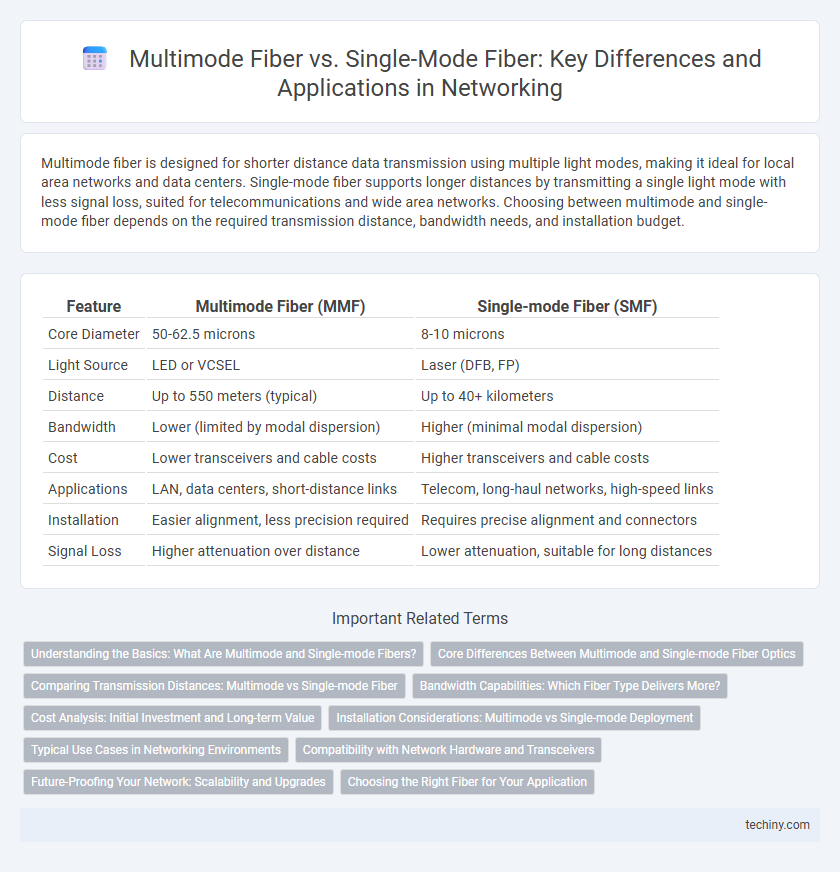Multimode fiber is designed for shorter distance data transmission using multiple light modes, making it ideal for local area networks and data centers. Single-mode fiber supports longer distances by transmitting a single light mode with less signal loss, suited for telecommunications and wide area networks. Choosing between multimode and single-mode fiber depends on the required transmission distance, bandwidth needs, and installation budget.
Table of Comparison
| Feature | Multimode Fiber (MMF) | Single-mode Fiber (SMF) |
|---|---|---|
| Core Diameter | 50-62.5 microns | 8-10 microns |
| Light Source | LED or VCSEL | Laser (DFB, FP) |
| Distance | Up to 550 meters (typical) | Up to 40+ kilometers |
| Bandwidth | Lower (limited by modal dispersion) | Higher (minimal modal dispersion) |
| Cost | Lower transceivers and cable costs | Higher transceivers and cable costs |
| Applications | LAN, data centers, short-distance links | Telecom, long-haul networks, high-speed links |
| Installation | Easier alignment, less precision required | Requires precise alignment and connectors |
| Signal Loss | Higher attenuation over distance | Lower attenuation, suitable for long distances |
Understanding the Basics: What Are Multimode and Single-mode Fibers?
Multimode fiber uses a larger core diameter, typically 50 or 62.5 microns, allowing multiple light modes to propagate simultaneously, making it ideal for short-distance data transmission within buildings or campuses. Single-mode fiber features a much smaller core, around 8 to 10 microns, enabling only one light mode to travel straight through, providing higher bandwidth and longer distance capabilities suitable for telecommunications and wide-area network backbones.
Core Differences Between Multimode and Single-mode Fiber Optics
Multimode fiber features a larger core diameter, typically 50 or 62.5 microns, allowing multiple light modes to propagate for short-distance data transmission. Single-mode fiber has a much smaller core, around 8 to 10 microns, enabling a single light mode to travel longer distances with higher bandwidth and lower attenuation, making it ideal for telecommunications and long-haul networks.
Comparing Transmission Distances: Multimode vs Single-mode Fiber
Multimode fiber typically supports transmission distances up to 2 kilometers using LED or VCSEL sources, making it ideal for short-range applications like data centers and local area networks. Single-mode fiber enables much longer transmission distances, exceeding 40 kilometers with laser sources, due to its minimal modal dispersion and smaller core diameter. This distinction in transmission reach influences network design choices where multimode suits shorter connections, while single-mode fibers are preferred for long-haul and metropolitan area networks.
Bandwidth Capabilities: Which Fiber Type Delivers More?
Multimode fiber supports bandwidths up to 10 Gbps over distances typically within 550 meters, making it suitable for short-range networking such as data centers and campus networks. Single-mode fiber delivers significantly higher bandwidth capabilities, exceeding 100 Gbps over distances of several kilometers, ideal for long-haul telecommunication and high-speed internet infrastructure. The inherent design of single-mode fiber, with a smaller core diameter, reduces modal dispersion, enabling greater bandwidth and extended reach compared to multimode fiber.
Cost Analysis: Initial Investment and Long-term Value
Multimode fiber generally incurs lower initial costs due to cheaper transceivers and cabling, making it suitable for short-distance applications within data centers or enterprise environments. Single-mode fiber demands higher upfront investment for optical components but offers superior scalability and lower signal attenuation, resulting in reduced maintenance and upgrade expenses over time for long-haul or high-bandwidth networks. Evaluating total cost of ownership reveals that while multimode fiber is cost-effective initially, single-mode fiber delivers better long-term value through enhanced performance and future-proofing capabilities.
Installation Considerations: Multimode vs Single-mode Deployment
Multimode fiber installation is generally easier and more cost-effective for shorter distances due to its larger core size, which allows for simple alignment and less stringent connector precision. Single-mode fiber deployment requires precise splicing and connector techniques because of its smaller core diameter, making it more suitable for long-distance, high-bandwidth networks where signal integrity is critical. Choosing between multimode and single-mode fiber depends on the specific network requirements, distance, and budget constraints, impacting labor costs and installation complexity.
Typical Use Cases in Networking Environments
Multimode fiber is typically used for short-distance applications such as data centers, local area networks (LANs), and enterprise backbone connections due to its cost-effectiveness and easier termination. Single-mode fiber is preferred for long-distance telecommunications, metropolitan area networks (MANs), and high-speed internet backbone links because of its low attenuation and higher bandwidth capabilities. Network architects select multimode fiber for intra-building connectivity while relying on single-mode fiber to span multiple buildings or cities.
Compatibility with Network Hardware and Transceivers
Multimode fiber is compatible with short-range network hardware and commonly uses lower-cost, LED-based transceivers, making it ideal for local area networks and data centers. Single-mode fiber supports long-distance communication and requires laser-based transceivers designed for higher precision and performance, suitable for metropolitan and wide-area networks. Selecting compatible transceivers and network devices is critical to optimizing signal integrity and minimizing latency across fiber optic installations.
Future-Proofing Your Network: Scalability and Upgrades
Single-mode fiber offers superior future-proofing for network scalability with higher bandwidth capacity and longer transmission distances, supporting emerging technologies like 5G and high-speed data centers. Multimode fiber is cost-effective for short-range applications but faces limitations in upgrade paths due to modal dispersion and lower bandwidth potential. Investing in single-mode infrastructure enables seamless integration of advanced communication standards, ensuring greater longevity and adaptability of your network.
Choosing the Right Fiber for Your Application
Selecting the appropriate fiber optic cable depends on distance, bandwidth, and cost considerations: multimode fiber supports shorter distances up to 600 meters with lower bandwidth but offers economical installation, making it ideal for data centers and LANs. Single-mode fiber provides higher bandwidth over long distances exceeding 10 kilometers, suitable for telecommunications and metro networks despite higher initial expenses. Assessing application requirements such as transmission distance and network speed ensures optimal performance and cost-efficiency in fiber optic deployment.
Multimode Fiber vs Single-mode Fiber Infographic

 techiny.com
techiny.com